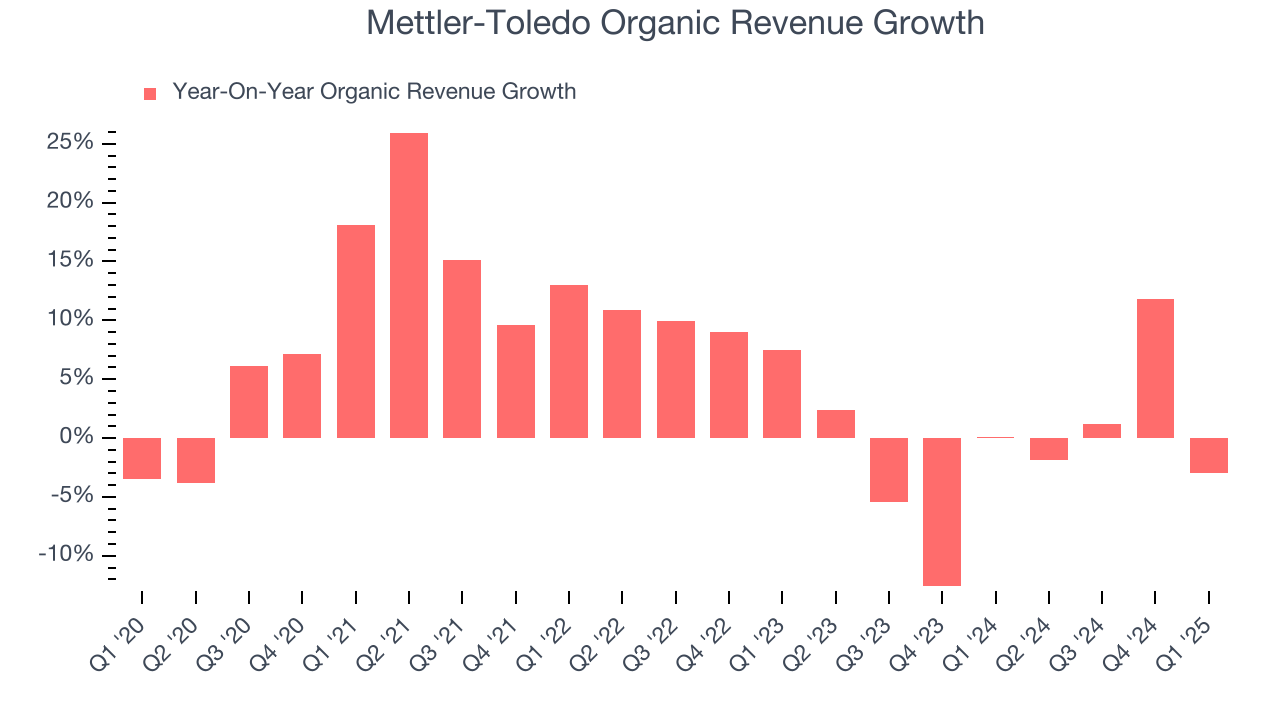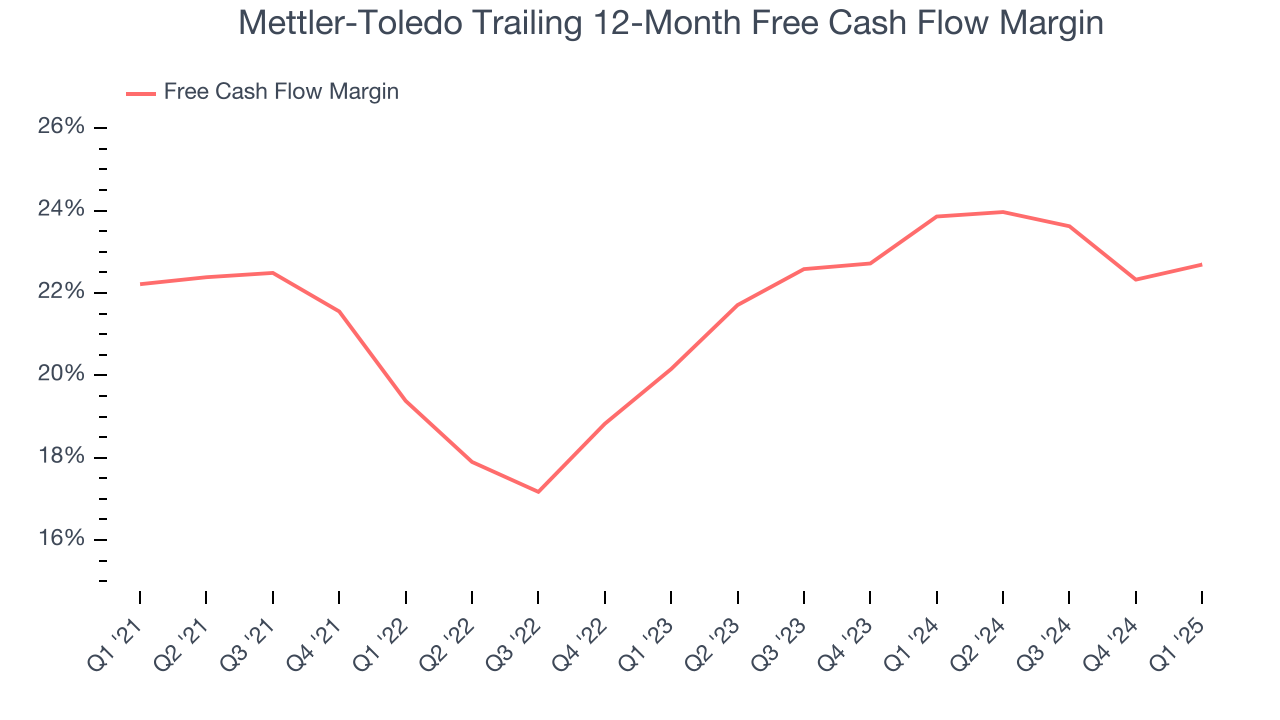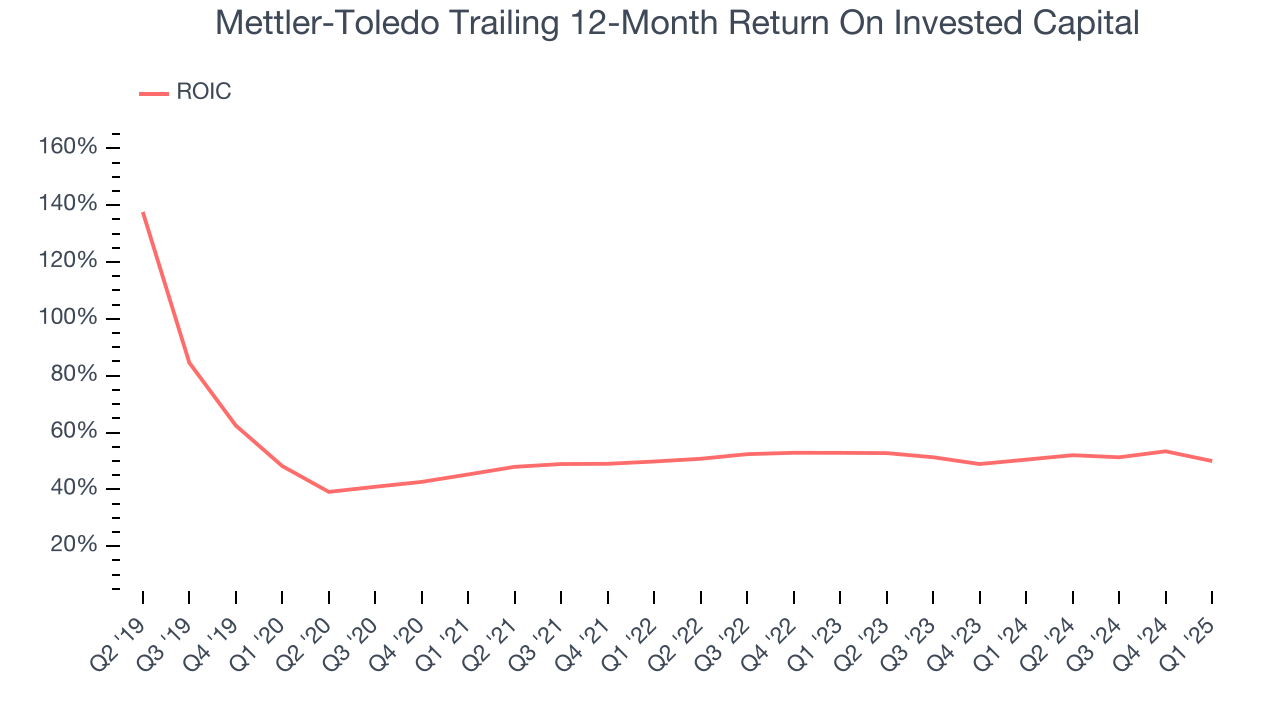
Mettler-Toledo (MTD)
Mettler-Toledo doesn’t impress us. Its sluggish sales growth shows demand is soft, a worrisome sign for investors in high-quality stocks.― StockStory Analyst Team
1. News
2. Summary
Why Mettler-Toledo Is Not Exciting
With roots dating back to the precision balance innovations of Swiss engineer Erhard Mettler, Mettler-Toledo (NYSE:MTD) manufactures precision weighing instruments, analytical equipment, and product inspection systems used in laboratories, industrial settings, and food retail.
- Organic sales performance over the past two years indicates the company may need to make strategic adjustments or rely on M&A to catalyze faster growth
- Muted 5.2% annual revenue growth over the last five years shows its demand lagged behind its healthcare peers
- One positive is that its stellar returns on capital showcase management’s ability to surface highly profitable business ventures, and its rising returns show it’s making even more lucrative bets


Mettler-Toledo doesn’t fulfill our quality requirements. There are more rewarding stocks elsewhere.
Why There Are Better Opportunities Than Mettler-Toledo
High Quality
Investable
Underperform
Why There Are Better Opportunities Than Mettler-Toledo
Mettler-Toledo is trading at $1,184 per share, or 27.2x forward P/E. Not only does Mettler-Toledo trade at a premium to companies in the healthcare space, but this multiple is also high for its top-line growth.
There are stocks out there featuring similar valuation multiples with better fundamentals. We prefer to invest in those.
3. Mettler-Toledo (MTD) Research Report: Q1 CY2025 Update
Precision measurement company Mettler-Toledo (NYSE:MTD) beat Wall Street’s revenue expectations in Q1 CY2025, but sales fell by 4.6% year on year to $883.7 million. Its non-GAAP profit of $8.19 per share was 3.9% above analysts’ consensus estimates.
Mettler-Toledo (MTD) Q1 CY2025 Highlights:
- Revenue: $883.7 million vs analyst estimates of $875.1 million (4.6% year-on-year decline, 1% beat)
- Adjusted EPS: $8.19 vs analyst estimates of $7.88 (3.9% beat)
- Management lowered its full-year Adjusted EPS guidance to $41.63 at the midpoint, a 2.5% decrease
- Operating Margin: 22.9%, down from 26.9% in the same quarter last year
- Free Cash Flow Margin: 20.1%, up from 18.6% in the same quarter last year
- Organic Revenue fell 3% year on year (0.1% in the same quarter last year)
- Market Capitalization: $22.31 billion
Company Overview
With roots dating back to the precision balance innovations of Swiss engineer Erhard Mettler, Mettler-Toledo (NYSE:MTD) manufactures precision weighing instruments, analytical equipment, and product inspection systems used in laboratories, industrial settings, and food retail.
The company's product portfolio spans several categories, each serving specific market needs. In laboratories, Mettler-Toledo's balances can measure weights from one ten-millionth of a gram up to 64 kilograms, while its analytical instruments like titrators, pH meters, and thermal analysis systems help scientists analyze chemical compositions and material properties. For industrial customers, the company provides weighing instruments, terminals, and software that integrate into manufacturing processes for quality control and automation.
Product inspection represents another key business area, where Mettler-Toledo's metal detectors, x-ray systems, and checkweighers ensure product safety and compliance in food processing, pharmaceuticals, and consumer goods. The company also serves food retailers with weighing and labeling solutions for fresh goods management.
A pharmaceutical researcher might use a Mettler-Toledo analytical balance to precisely weigh compounds for drug formulation, then employ the company's automated chemistry solutions to monitor the reaction in real-time, ensuring consistent quality. Meanwhile, a food manufacturer might install Mettler-Toledo's checkweighers and metal detectors on production lines to verify product weight and detect potential contaminants before packaging.
The company generates revenue through equipment sales and a substantial service business that provides calibration, compliance, and maintenance services. With manufacturing facilities across China, Switzerland, the United States, Germany, the United Kingdom, and Mexico, Mettler-Toledo maintains a global presence, selling its products in more than 140 countries with direct operations in approximately 40 nations.
Mettler-Toledo's business is organized into five reportable segments: U.S. Operations, Swiss Operations, Western European Operations, Chinese Operations, and Other Operations, reflecting its geographically diversified structure with sales derived from North and South America, Europe, and Asia.
4. Research Tools & Consumables
The life sciences subsector specializing in research tools and consumables enables scientific discoveries across academia, biotechnology, and pharmaceuticals. These firms supply a wide range of essential laboratory products, ensuring a recurring revenue stream through repeat purchases and replenishment. Their business models benefit from strong customer loyalty, a diversified product portfolio, and exposure to both the research and clinical markets. However, challenges include high R&D investment to maintain technological leadership, pricing pressures from budget-conscious institutions, and vulnerability to fluctuations in research funding cycles. Looking ahead, this subsector stands to benefit from tailwinds such as growing demand for tools supporting emerging fields like synthetic biology and personalized medicine. There is also a rise in automation and AI-driven solutions in laboratories that could create new opportunities to sell tools and consumables. Nevertheless, headwinds exist. These companies tend to be at the mercy of supply chain disruptions and sensitivity to macroeconomic conditions that impact funding for research initiatives.
Mettler-Toledo's competitors include Sartorius (OTC:SARTF), Thermo Fisher Scientific (NYSE:TMO), Shimadzu Corporation (OTC:SHMDF), and Agilent Technologies (NYSE:A), which all manufacture various types of precision instruments and analytical equipment.
5. Economies of Scale
Larger companies benefit from economies of scale, where fixed costs like infrastructure, technology, and administration are spread over a higher volume of goods or services, reducing the cost per unit. Scale can also lead to bargaining power with suppliers, greater brand recognition, and more investment firepower. A virtuous cycle can ensue if a scaled company plays its cards right.
With $3.83 billion in revenue over the past 12 months, Mettler-Toledo has decent scale. This is important as it gives the company more leverage in a heavily regulated, competitive environment that is complex and resource-intensive.
6. Sales Growth
A company’s long-term sales performance can indicate its overall quality. Any business can put up a good quarter or two, but the best consistently grow over the long haul. Over the last five years, Mettler-Toledo grew its sales at a mediocre 5.2% compounded annual growth rate. This was below our standard for the healthcare sector and is a rough starting point for our analysis.

Long-term growth is the most important, but within healthcare, a half-decade historical view may miss new innovations or demand cycles. Mettler-Toledo’s performance shows it grew in the past but relinquished its gains over the last two years, as its revenue fell by 1.5% annually. 
Mettler-Toledo also reports organic revenue, which strips out one-time events like acquisitions and currency fluctuations that don’t accurately reflect its fundamentals. Over the last two years, Mettler-Toledo’s organic revenue was flat. Because this number aligns with its normal revenue growth, we can see the company’s core operations (not acquisitions and divestitures) drove most of its results. 
This quarter, Mettler-Toledo’s revenue fell by 4.6% year on year to $883.7 million but beat Wall Street’s estimates by 1%.
Looking ahead, sell-side analysts expect revenue to grow 3.2% over the next 12 months. Although this projection implies its newer products and services will catalyze better top-line performance, it is still below the sector average.
7. Operating Margin
Operating margin is an important measure of profitability as it shows the portion of revenue left after accounting for all core expenses – everything from the cost of goods sold to advertising and wages. It’s also useful for comparing profitability across companies with different levels of debt and tax rates because it excludes interest and taxes.
Mettler-Toledo has been an efficient company over the last five years. It was one of the more profitable businesses in the healthcare sector, boasting an average operating margin of 27.9%.
Looking at the trend in its profitability, Mettler-Toledo’s operating margin rose by 1.9 percentage points over the last five years, as its sales growth gave it operating leverage. This performance was mostly driven by its past improvements as the company’s margin was relatively unchanged on two-year basis.

In Q1, Mettler-Toledo generated an operating profit margin of 22.9%, down 4.1 percentage points year on year. This contraction shows it was less efficient because its expenses increased relative to its revenue.
8. Earnings Per Share
Revenue trends explain a company’s historical growth, but the long-term change in earnings per share (EPS) points to the profitability of that growth – for example, a company could inflate its sales through excessive spending on advertising and promotions.
Mettler-Toledo’s EPS grew at a spectacular 12.1% compounded annual growth rate over the last five years, higher than its 5.2% annualized revenue growth. This tells us the company became more profitable on a per-share basis as it expanded.

Diving into Mettler-Toledo’s quality of earnings can give us a better understanding of its performance. As we mentioned earlier, Mettler-Toledo’s operating margin declined this quarter but expanded by 1.9 percentage points over the last five years. Its share count also shrank by 14%, and these factors together are positive signs for shareholders because improving profitability and share buybacks turbocharge EPS growth relative to revenue growth. 
In Q1, Mettler-Toledo reported EPS at $8.19, down from $8.89 in the same quarter last year. Despite falling year on year, this print beat analysts’ estimates by 3.9%. Over the next 12 months, Wall Street expects Mettler-Toledo’s full-year EPS of $40.46 to grow 7.6%.
9. Cash Is King
Free cash flow isn't a prominently featured metric in company financials and earnings releases, but we think it's telling because it accounts for all operating and capital expenses, making it tough to manipulate. Cash is king.
Mettler-Toledo has shown robust cash profitability, giving it an edge over its competitors and the ability to reinvest or return capital to investors. The company’s free cash flow margin averaged 21.6% over the last five years, quite impressive for a healthcare business.
Taking a step back, we can see that Mettler-Toledo’s margin was unchanged during that time, showing its long-term free cash flow profile is stable.

Mettler-Toledo’s free cash flow clocked in at $177.2 million in Q1, equivalent to a 20.1% margin. This result was good as its margin was 1.4 percentage points higher than in the same quarter last year, but we wouldn’t read too much into the short term because investment needs can be seasonal, causing temporary swings. Long-term trends trump fluctuations.
10. Return on Invested Capital (ROIC)
EPS and free cash flow tell us whether a company was profitable while growing its revenue. But was it capital-efficient? Enter ROIC, a metric showing how much operating profit a company generates relative to the money it has raised (debt and equity).
Although Mettler-Toledo hasn’t been the highest-quality company lately, it found a few growth initiatives in the past that worked out wonderfully. Its five-year average ROIC was 49.7%, splendid for a healthcare business.

We like to invest in businesses with high returns, but the trend in a company’s ROIC is what often surprises the market and moves the stock price. On average, Mettler-Toledo’s ROIC increased by 2.7 percentage points annually over the last few years. This is a good sign, and if its returns keep rising, there’s a chance it could evolve into an investable business.
11. Balance Sheet Assessment
Mettler-Toledo reported $64.29 million of cash and $2.07 billion of debt on its balance sheet in the most recent quarter. As investors in high-quality companies, we primarily focus on two things: 1) that a company’s debt level isn’t too high and 2) that its interest payments are not excessively burdening the business.

With $1.29 billion of EBITDA over the last 12 months, we view Mettler-Toledo’s 1.6× net-debt-to-EBITDA ratio as safe. We also see its $72.05 million of annual interest expenses as appropriate. The company’s profits give it plenty of breathing room, allowing it to continue investing in growth initiatives.
12. Key Takeaways from Mettler-Toledo’s Q1 Results
It was good to see Mettler-Toledo narrowly top analysts’ revenue expectations this quarter. We were also happy its EPS outperformed. On the other hand, its full-year EPS guidance fell short of Wall Street’s estimates. Overall, this quarter could have been better. The stock remained flat at $1,050 immediately after reporting.
13. Is Now The Time To Buy Mettler-Toledo?
Updated: June 6, 2025 at 11:51 PM EDT
Before investing in or passing on Mettler-Toledo, we urge you to understand the company’s business quality (or lack thereof), valuation, and the latest quarterly results - in that order.
Mettler-Toledo isn’t a bad business, but we have other favorites. Although its revenue growth was mediocre over the last five years and analysts expect growth to slow over the next 12 months, its stellar ROIC suggests it has been a well-run company historically. Tread carefully with this one, however, as its flat organic revenue disappointed.
Mettler-Toledo’s P/E ratio based on the next 12 months is 27.2x. This multiple tells us a lot of good news is priced in - you can find better investment opportunities elsewhere.
Wall Street analysts have a consensus one-year price target of $1,245 on the company (compared to the current share price of $1,184).









